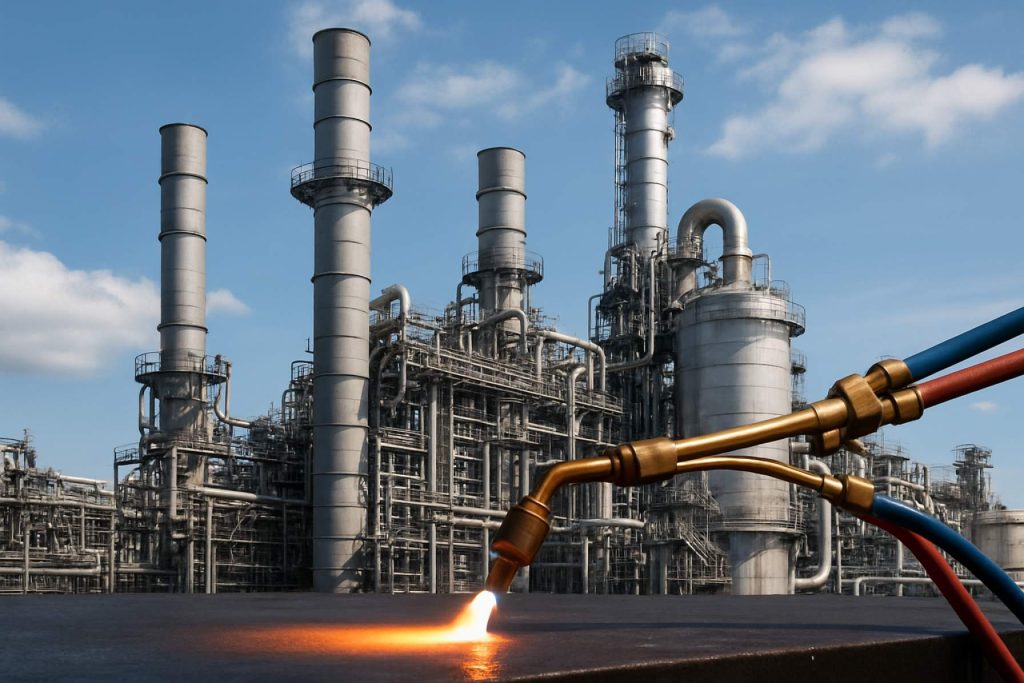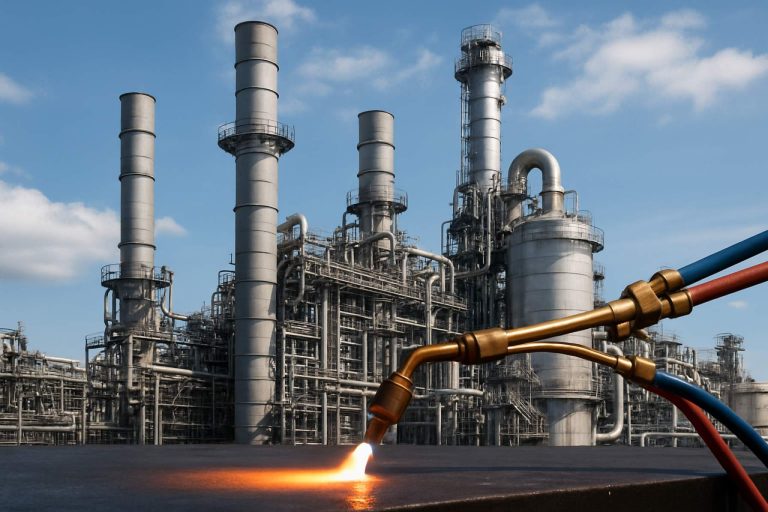
Oxyfuel Gasification Technologies Market Report 2025: In-Depth Analysis of Growth Drivers, Trends, and Regional Opportunities. Explore Market Size, Competitive Dynamics, and Future Outlook Through 2030.
- Executive Summary & Market Overview
- Key Technology Trends in Oxyfuel Gasification
- Competitive Landscape and Leading Players
- Market Growth Forecasts (2025–2030): CAGR, Revenue, and Volume Analysis
- Regional Market Analysis: North America, Europe, Asia-Pacific, and Rest of World
- Challenges, Risks, and Emerging Opportunities
- Future Outlook: Strategic Recommendations and Investment Insights
- Sources & References
Executive Summary & Market Overview
Oxyfuel gasification technologies represent a transformative approach within the broader gasification market, leveraging pure oxygen or oxygen-enriched air instead of atmospheric air to convert carbonaceous feedstocks—such as coal, biomass, or waste—into syngas. This process yields a syngas with higher concentrations of carbon monoxide and hydrogen, while significantly reducing nitrogen dilution, thus facilitating easier carbon capture and storage (CCS). As of 2025, the global market for oxyfuel gasification is experiencing robust growth, driven by escalating demand for cleaner energy solutions, tightening emissions regulations, and the increasing adoption of CCS in industrial sectors.
According to recent market analyses, the global gasification market is projected to surpass USD 600 billion by 2027, with oxyfuel technologies accounting for a growing share due to their compatibility with decarbonization strategies and hydrogen production initiatives (MarketsandMarkets). The Asia-Pacific region, led by China and India, remains the largest adopter, propelled by large-scale coal-to-chemicals and waste-to-energy projects. Meanwhile, Europe and North America are witnessing increased investments in oxyfuel gasification for industrial decarbonization and green hydrogen production, supported by policy incentives and net-zero commitments (International Energy Agency).
Key industry players—including Air Liquide, Siemens Energy, and Shell—are actively developing and commercializing advanced oxyfuel gasification systems. These systems are being integrated into new and retrofitted plants, particularly in sectors such as chemicals, power generation, and waste management. The technology’s ability to produce a concentrated CO2 stream aligns with the growing deployment of CCS infrastructure, further enhancing its market appeal (Global CCS Institute).
- Drivers: Stringent emissions regulations, rising demand for low-carbon hydrogen, and the need for efficient waste management solutions.
- Challenges: High capital costs, operational complexity, and the need for reliable oxygen supply infrastructure.
- Opportunities: Integration with renewable energy, expansion into emerging markets, and advancements in modular and small-scale gasification units.
In summary, oxyfuel gasification technologies are poised for accelerated adoption in 2025, underpinned by global decarbonization trends, technological advancements, and supportive policy frameworks. The sector’s evolution will be shaped by continued innovation, strategic partnerships, and the scaling of CCS-enabled value chains.
Key Technology Trends in Oxyfuel Gasification
Oxyfuel gasification technologies are at the forefront of innovation in the pursuit of low-carbon energy and industrial processes. Unlike conventional air-blown gasification, oxyfuel gasification uses pure oxygen or oxygen-enriched air as the oxidant, resulting in a syngas with higher concentrations of CO2 and H2, and a flue gas stream that is easier to process for carbon capture and storage (CCS). As of 2025, several key technology trends are shaping the development and deployment of oxyfuel gasification systems.
- Integration with Carbon Capture and Storage (CCS): Oxyfuel gasification is increasingly being designed for seamless integration with CCS infrastructure. The high-purity CO2 stream produced simplifies capture and compression, reducing overall costs and energy penalties. Projects such as those supported by the Global CCS Institute demonstrate the commercial viability of this approach, particularly for decarbonizing hard-to-abate sectors like steel and cement.
- Advancements in Oxygen Production: The cost and energy intensity of oxygen production remain significant barriers. However, innovations in air separation technologies, such as ion transport membranes and advanced cryogenic processes, are reducing both capital and operational expenditures. Companies like Air Liquide and Linde are leading efforts to commercialize these next-generation oxygen supply systems.
- Feedstock Flexibility and Co-Gasification: Modern oxyfuel gasifiers are being engineered to handle a wider range of feedstocks, including biomass, municipal solid waste, and industrial byproducts. This flexibility supports circular economy initiatives and enhances the sustainability profile of gasification plants. The International Energy Agency (IEA) highlights co-gasification as a key trend for maximizing resource efficiency and reducing lifecycle emissions.
- Digitalization and Process Optimization: The adoption of advanced sensors, real-time analytics, and AI-driven process controls is improving the efficiency, reliability, and safety of oxyfuel gasification plants. Digital twins and predictive maintenance are being deployed by technology providers such as Siemens Energy to optimize plant performance and reduce downtime.
- Scale-Up and Modularization: There is a growing trend toward modular, scalable oxyfuel gasification units that can be rapidly deployed and integrated into existing industrial sites. This approach lowers investment risk and accelerates market adoption, as noted in recent market analyses by Wood Mackenzie.
Collectively, these trends are positioning oxyfuel gasification as a cornerstone technology for the transition to a low-carbon, resource-efficient industrial future in 2025 and beyond.
Competitive Landscape and Leading Players
The competitive landscape for oxyfuel gasification technologies in 2025 is characterized by a mix of established industrial conglomerates, specialized technology providers, and emerging innovators. The market is driven by the growing demand for low-carbon hydrogen, syngas, and cleaner power generation, as well as tightening global emissions regulations. Oxyfuel gasification, which uses pure oxygen instead of air, enables higher efficiency and easier carbon capture, making it a focal point for decarbonization strategies in heavy industries and power generation.
Leading players in this sector include Air Liquide, Linde plc, and Air Products and Chemicals, Inc., all of which leverage their expertise in industrial gases and large-scale oxygen production to offer integrated oxyfuel gasification solutions. These companies have formed strategic partnerships with utilities, refineries, and chemical manufacturers to deploy commercial-scale projects, particularly in Europe, North America, and East Asia.
Technology licensors such as Shell and GE Vernova (formerly GE Power) play a pivotal role by providing proprietary gasification processes and engineering services. Shell’s Shell Gasification Process (SGP) and GE’s gasification technologies are widely adopted in coal-to-chemicals and waste-to-energy applications, with ongoing R&D to optimize oxyfuel integration and carbon capture readiness.
Emerging players and innovators are also shaping the competitive landscape. Companies like thyssenkrupp Industrial Solutions and Siemens Energy are advancing modular and flexible oxyfuel gasification systems, targeting decentralized hydrogen production and waste valorization. Startups and research consortia, often supported by government funding in the EU and China, are piloting novel reactor designs and process intensification techniques to reduce capital and operational costs.
- MarketsandMarkets projects continued consolidation, with leading players expanding through joint ventures and technology licensing.
- Strategic alliances between technology providers and end-users are accelerating commercialization, especially in regions with strong policy incentives for carbon capture and utilization.
- Intellectual property and process know-how remain key differentiators, with patent activity intensifying around oxygen production, reactor design, and integration with carbon capture systems.
Overall, the competitive landscape in 2025 is dynamic, with established industrial gas companies, technology licensors, and agile innovators all vying for leadership in the rapidly evolving oxyfuel gasification market.
Market Growth Forecasts (2025–2030): CAGR, Revenue, and Volume Analysis
The global market for oxyfuel gasification technologies is poised for robust growth between 2025 and 2030, driven by increasing demand for cleaner energy solutions and stringent carbon emission regulations. According to projections by MarketsandMarkets, the oxyfuel gasification market is expected to register a compound annual growth rate (CAGR) of approximately 8.2% during this period. This growth is underpinned by the rising adoption of carbon capture, utilization, and storage (CCUS) technologies, as oxyfuel gasification enables the production of a concentrated CO2 stream, facilitating efficient capture and storage.
Revenue in the oxyfuel gasification sector is forecasted to reach USD 3.1 billion by 2030, up from an estimated USD 1.9 billion in 2025. This expansion is attributed to increased investments in large-scale demonstration projects, particularly in regions such as North America, Europe, and East Asia, where government policies are increasingly favoring low-carbon industrial processes. For instance, the European Union’s Green Deal and the U.S. Department of Energy’s support for clean hydrogen initiatives are catalyzing market growth by incentivizing the deployment of advanced gasification systems (International Energy Agency).
In terms of volume, the market is projected to witness a significant rise in installed capacity, with cumulative global oxyfuel gasification capacity expected to surpass 7 GWth (gigawatts thermal) by 2030, compared to approximately 4 GWth in 2025. This increase is largely driven by the chemical and power generation sectors, which are leveraging oxyfuel gasification for syngas production and integrated gasification combined cycle (IGCC) applications (Wood Mackenzie).
- Asia-Pacific is anticipated to lead in both revenue and volume growth, propelled by China’s and India’s investments in clean coal and waste-to-energy projects.
- Europe is expected to see accelerated adoption due to regulatory mandates and funding for decarbonization technologies.
- North America will benefit from federal incentives and private sector partnerships, particularly in the U.S. Gulf Coast region.
Overall, the 2025–2030 period will be characterized by technological advancements, policy-driven investments, and a growing emphasis on sustainable industrial processes, all of which will contribute to the steady expansion of the oxyfuel gasification technologies market.
Regional Market Analysis: North America, Europe, Asia-Pacific, and Rest of World
The regional market dynamics for oxyfuel gasification technologies in 2025 reflect varying levels of adoption, regulatory support, and industrial demand across North America, Europe, Asia-Pacific, and the Rest of the World.
- North America: The North American market, led by the United States and Canada, is characterized by robust investments in clean energy and carbon capture initiatives. Oxyfuel gasification is gaining traction as a pathway to low-carbon hydrogen and synthetic fuels, supported by government incentives such as the Inflation Reduction Act and the U.S. Department of Energy’s funding for carbon management projects (U.S. Department of Energy). The region’s mature industrial base and focus on decarbonizing power and chemical sectors are driving pilot and commercial-scale deployments, particularly in states with aggressive emissions targets.
- Europe: Europe remains at the forefront of oxyfuel gasification technology development, propelled by stringent climate policies and the European Union’s Green Deal. Countries like Germany, the Netherlands, and the UK are investing in demonstration plants and integrating oxyfuel gasification with carbon capture and storage (CCS) infrastructure (European Commission). The region’s emphasis on circular economy and hydrogen strategies is fostering partnerships between technology providers and utilities, with a focus on retrofitting existing coal and biomass plants.
- Asia-Pacific: The Asia-Pacific region, particularly China, Japan, and South Korea, is witnessing rapid growth in oxyfuel gasification adoption. China’s push for cleaner coal utilization and industrial decarbonization is spurring large-scale projects, while Japan and South Korea are leveraging oxyfuel gasification for hydrogen production and ammonia synthesis (International Energy Agency). Government-backed R&D programs and public-private collaborations are accelerating technology transfer and localization, although cost and infrastructure challenges persist.
- Rest of World: In other regions, including Latin America and the Middle East, adoption remains nascent but is expected to grow as energy-exporting countries seek to diversify and decarbonize their portfolios. Pilot projects in countries like Saudi Arabia and Brazil are exploring the integration of oxyfuel gasification with renewable energy and CCS, often in partnership with international technology firms (Wood Mackenzie).
Overall, the global landscape for oxyfuel gasification in 2025 is shaped by regional policy frameworks, industrial demand, and the pace of CCS infrastructure development, with Europe and Asia-Pacific leading in deployment and innovation.
Challenges, Risks, and Emerging Opportunities
Oxyfuel gasification technologies, which utilize pure oxygen instead of air for the gasification of carbonaceous feedstocks, are gaining traction due to their potential for high-efficiency syngas production and inherent carbon capture capabilities. However, the sector faces a complex landscape of challenges and risks, even as new opportunities emerge in 2025.
Challenges and Risks
- High Operational Costs: The production and supply of pure oxygen, typically via cryogenic air separation units, significantly increase the operational costs of oxyfuel gasification compared to conventional air-blown systems. This cost premium remains a major barrier to widespread adoption, especially in regions with low energy prices or limited infrastructure (International Energy Agency).
- Technical Complexity: Oxyfuel gasification systems require advanced materials and engineering solutions to handle high temperatures and corrosive environments. The integration of oxygen supply, gas cleanup, and carbon capture units adds further complexity, increasing the risk of operational downtime and maintenance challenges (Global CCS Institute).
- Feedstock Flexibility: While oxyfuel gasification can process a range of feedstocks, variability in feedstock quality (e.g., moisture, ash content) can impact process stability and syngas composition, necessitating robust pre-treatment and control systems (IEA Clean Coal Centre).
- Regulatory and Market Uncertainty: The economic viability of oxyfuel gasification is closely tied to carbon pricing, emissions regulations, and incentives for low-carbon technologies. Uncertainty in policy frameworks, especially in emerging markets, poses a risk to long-term investment (World Bank).
Emerging Opportunities
- Carbon Capture, Utilization, and Storage (CCUS): Oxyfuel gasification produces a concentrated CO2 stream, simplifying capture and storage. As global CCUS deployment accelerates, this technology is well-positioned to benefit from new infrastructure and policy support (International Energy Agency).
- Hydrogen Economy: The high-purity syngas produced is a valuable feedstock for low-carbon hydrogen production, aligning with government and industry initiatives to scale up the hydrogen economy (Hydrogen Council).
- Industrial Decarbonization: Hard-to-abate sectors such as steel, cement, and chemicals are exploring oxyfuel gasification as a pathway to reduce emissions, supported by pilot projects and public-private partnerships (International Energy Agency).
In summary, while oxyfuel gasification technologies face significant technical and economic hurdles, the convergence of climate policy, CCUS infrastructure, and the hydrogen transition is creating new growth avenues for 2025 and beyond.
Future Outlook: Strategic Recommendations and Investment Insights
The future outlook for oxyfuel gasification technologies in 2025 is shaped by a confluence of regulatory, economic, and technological drivers. As global decarbonization efforts intensify, oxyfuel gasification—where pure oxygen replaces air in the gasification process to produce a concentrated CO2 stream—emerges as a pivotal solution for both power generation and industrial applications. The technology’s inherent compatibility with carbon capture, utilization, and storage (CCUS) positions it at the forefront of low-carbon energy strategies, especially in regions with stringent emissions targets.
Strategically, stakeholders should prioritize investments in integrated oxyfuel gasification and CCUS projects. The International Energy Agency projects that CCUS-equipped facilities will be essential to meet net-zero goals, with oxyfuel gasification offering a cost-effective pathway for hard-to-abate sectors such as cement, steel, and chemicals (International Energy Agency). Companies should also monitor policy developments, as government incentives and carbon pricing mechanisms are expected to accelerate project viability and returns, particularly in North America, Europe, and East Asia.
From an investment perspective, early movers in oxyfuel gasification stand to benefit from first-mover advantages, including access to pilot funding, technology partnerships, and long-term offtake agreements. Strategic alliances with technology providers and engineering firms—such as those led by Siemens Energy and GE—can mitigate technical risks and accelerate commercialization. Investors should also consider the scalability of modular oxyfuel gasification units, which offer flexibility for distributed energy and industrial applications, reducing capital intensity and deployment timelines (Wood Mackenzie).
- Recommendation 1: Focus on regions with supportive regulatory frameworks and established CO2 infrastructure to maximize project feasibility and revenue streams.
- Recommendation 2: Invest in R&D for process optimization, particularly in oxygen production and heat integration, to drive down operational costs and improve efficiency.
- Recommendation 3: Pursue partnerships with industrial emitters seeking decarbonization solutions, leveraging oxyfuel gasification’s ability to deliver high-purity syngas and facilitate CCUS.
In summary, the 2025 outlook for oxyfuel gasification technologies is robust, with strategic investments and targeted partnerships poised to unlock significant value as the global energy transition accelerates (BloombergNEF).
Sources & References
- MarketsandMarkets
- International Energy Agency
- Air Liquide
- Siemens Energy
- Shell
- Global CCS Institute
- Linde
- Wood Mackenzie
- GE Vernova
- European Commission
- World Bank
- Hydrogen Council
- BloombergNEF



